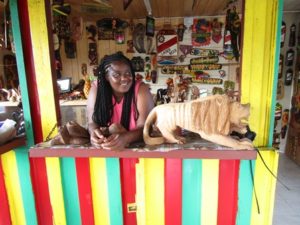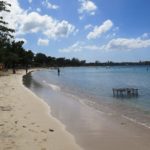A beach in Negril.
Photos/submitted
By Victor Block
One meal my wife Fyllis and I will long remember was a gourmet five-course candle-lit dinner served in a romantic setting. The other was a simple vegetarian lunch at a ramshackle lean-to perched precariously on a steep mountainside.

It’s not often that two repasts encapsulate much that a destination has to offer visitors, but Jamaica is such a place. The Chef’s Showcase dinner dished up at the Sunset at the Palms resort had little in common with the modest spread prepared by Fire, a Rastafarian man of uncertain age.
This is one example of the diversity that greets travelers to Jamaica. That island-nation has an abundance of magnificent beaches, a long list of outdoor activities, an intriguing history and a rich cultural mélange.
Even tourist-magnet towns along the northern coastline demonstrate Jamaica’s split personality. Montego Bay is all hustle and bustle. Ocho Rios is more relaxed, except when one or more cruise ships disgorge their passengers. Negril overlooks the island’s finest beach. Port Antonio offers outdoor markets, a maze of narrow back streets and buildings whose dilapidated condition can’t hide the beauty of their Georgian architecture.

For visitors seeking excitement activities range from exploring the island by horseback or Jeep, and hiking and biking excursions, to climbing up mountains and scampering down into limestone caves. Those who prefer to commune with Mother Nature find plenty of alternatives. As if the island weren’t already a tropical paradise British colonists gilded the lily – literally – by importing flowers and fruits from around the world.
The Brits were preceded by Taino Indians, who arrived around 650 AD and Christopher Columbus, who dropped by in 1494. Spain controlled the island until 1655, when British forces took over. Jamaica became independent in 1962.
The Spanish introduced sugar cultivation and slavery, both of which were expanded by British settlers. Among reminders of the heyday of sugar, from the 17th to 19th centuries, are the “Great Houses” which plantation owners built. They ranged from grandiose to more modest, and provide insight into part of Jamaica’s past.
Halse Hall was built in 1680 on the foundation of a Spanish hacienda. It was constructed with the thick walls of a fortress for security.
Rose Hall comes with a legend concerning Annie Palmer who, according to the story, murdered three husbands, among others. Some people believe that Annie’s spirit haunts the grounds.
While Seville isn’t one of the more imposing plantation houses, what’s inside makes the structure, well, great. A museum traces Jamaica’s history, and displays artifacts from the times of the Taino, Spanish and British. Scattered around the grounds are portions of the sugar cane processing factory, the bookkeeper’s and overseer’s houses, and tiny huts where slaves lived.
Jungled mountains cover about 80 percent of Jamaica’s terrain, which is
laced with rushing rivers and tumbling waterfalls. Most famous is Dunn’s River Falls, which plummets 600 feet down a series of natural steps that people may climb, carefully and clutching the hand of other daring risk-takers.
A different water experience is a river trip through the verdant countryside. As Captain Gayle expertly piloted the bamboo raft transporting Fyllis and me along the Martha Brae River, he identified trees and flowers and described rusting equipment along the shore left over from sugar growing days.
For information go to visitjamaica.com.












